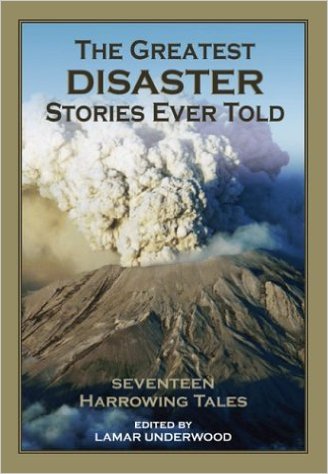Lamar Underwood. 2002. The Greatest Disaster Stories Ever Told. Lyons Press.

In this edited volume, Underwood excerpts disaster stories written by survivors, journalists and some best-selling authors, which describe a wide range of disastrous experiences for the benefit of a general audience.
He divides the 17 stories into six different sections. The stories in the first few sections include accounts of the September 11 attack on the World Trade Center, fires, the Mt. St. Helens eruption, the hurricane that wiped out Galveston, TX, in 1900, and the flood that inundated the city of Johnstown in Pennsylvania. Three tales of disaster at sea (the Titanic, the Lusitania, and the USS Indianapolis) comprise the fourth section. The fifth section features well-known “technological” catastrophes: the space shuttle Challenger explosion and the toxic gas that killed many people in Bhopal, India. The sixth section is about aviation accidents.
The stories in the fifth section are perhaps the most useful for scholars of Science and Technology Studies (STS). The Challenger and Bhopal disasters provide interesting case studies for students and teachers to compare with the tsunami and nuclear crisis at Fukushima. This account of Bhopal is excerpted from Dan Kurzman’s A Killing Wind: Inside Union Carbide and the Bhopal Catastrophe (1987), while the story of the space shuttle disaster is taken from Richard S. Lewis’s Challenger: The Final Voyage (1988). The authors are exceptional storytellers. Thus, these excerpts are particularly accessible for undergraduates, and may serve to complement more scholarly works such as chapters from Kim Fortun’s Advocacy After Bhopal (2001) or “The Naked Launch” from The Golem at Large (Collins & Pinch, 1998).
One drawback of the book is the heavy emphasis on disaster stories that mainly occurred in the United States. Moreover, the book was published in 2002, before many recent disasters occurred.
Anto Mohsin, Liberal Arts Department, Northwestern University in Qatar
![[Teach311 + COVID-19] Collective](https://blogs.ntu.edu.sg/teach311/files/2020/04/Banner.jpg)